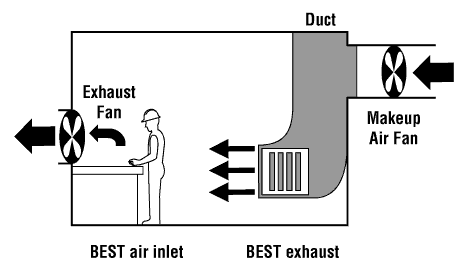
Desorption often is accomplished with distilled water or oxygenated solvents, again followed by analysis by either gas chromatography or other analytic approaches. In some cases, particularly for oxygenated hydrocarbon species, silica gel is used in testing. Similarly, many solvents are absorbed readily through the skin, and mere determination of airborne levels is not sufficient to determine the complete range of potential exposures. Such contaminants as lead are absorbed through both inhalation and ingestion, and both routes of intake must be considered in evaluation of the potential for harm. The task of determining the dose delivered to the worker may be further complicated by the existence of multiple pathways of absorption and metabolism. The effective dose depends on such things as particle sizes of dust in the air, the use of protective devices (ie, respirators and protective clothing), and the existence of other contaminants in the workplace. The mere existence of chemicals in the workplace or even in the workplace atmosphere does not necessarily mean that the chemicals are being delivered to a sensitive organ system in quantity sufficient to cause harm. + +Įxposure measurements are intended to be surrogates for determinations of doses delivered to the individual. As another example, changing weekly work schedules from five 8-hour days to three 12-hour days almost certainly will produce dislocation among the workforce because of the psychosocial and physical effects of shift work but also may lead to the danger of chemical intoxication if the chemical exposures are such as to lead to the buildup of excessive body burdens without the usual 16-hour “rest” period. Transplanting a successful chemical process from a unionized workplace in the United States or Canada to another country without understanding important cultural factors or the extent of the industrial experience in that country might cause significant risk of harm to the workers in that new country. Anticipation of health hazards may range from a reasonable expectation to mere speculation, but it implies that the industrial hygienist will understand the nature of changes in the processes, products, environments, and workforces of the workplace and how those changes might affect human health or well-being. The duty to anticipate health hazards in the workplace is a relatively new addition to the industrial hygienist's traditional responsibilities for recognition, evaluation, and control it is a heavy but necessary burden. Hazards arising from the workplace include the potential harm that may arise in the community by poorly controlled emissions and such issues as familial exposures from harmful debris taken home on workers' clothing.


On completion of the evaluation, the industrial hygienist then is in a position (in consultation with other members of the occupational health and safety team) to recommend and implement controls needed to reduce risks to within tolerable limits. On anticipation or recognition of a health hazard, the industrial hygienist should be able to identify measures necessary for proper evaluation. The anticipation and recognition of health hazards have primacy because they must take place before proper evaluation or control (if needed) can take place. Industrial hygienists use environmental monitoring and analytical methods to detect the extent of worker exposure and employ engineering, work practice controls, and other methods to control potential health hazards. Industrial hygiene is the science of anticipating, recognizing, evaluating, and controlling workplace conditions that may cause workers' injury or illness.


 0 kommentar(er)
0 kommentar(er)
